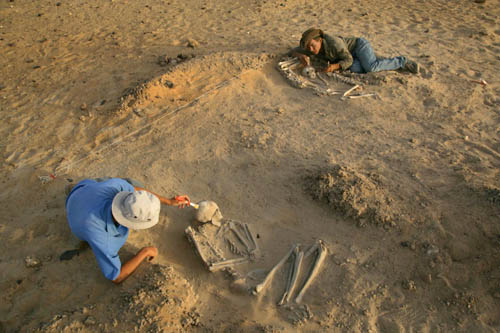 [Image: Archaeologists work at Gobero, "the largest graveyard discovered to date in the Sahara." Photo by Mike Hettwer, courtesy of National Geographic, otherwise unrelated to this post].
[Image: Archaeologists work at Gobero, "the largest graveyard discovered to date in the Sahara." Photo by Mike Hettwer, courtesy of National Geographic, otherwise unrelated to this post].Archaeologist Sara Gonzalez, we read, courtesy of an older post on Middle Savagery, "practices what she calls 'catch and release' archaeology." This means Gonzalez "plots all of the artifacts as they are excavated and then reburies the artifacts after analysis."
While you can apparently read more about her method in this paper, I'm intrigued by the more general idea of systematically reburying things for their later, contrived rediscovery. This sort of behavior seems all but guaranteed to upset the existing stratigraphy of a site—and thus, in fact, be archaeologically usless—but it also sets up an interesting relationship with subterranean artifacts. That is, objects inside the earth enter into a kind of regulated hide-and-seek with surface dwellers.
Anthropologically speaking, I would love to learn more about cultures that have practiced this strangely squirrel-like behavior: burying perhaps quite large-scale things, in a loop bordering on repetition-compulsion, so that someone can unearth them later, thus deliberately leaving traces that future humans might not even know how to look for.
No comments:
Post a Comment